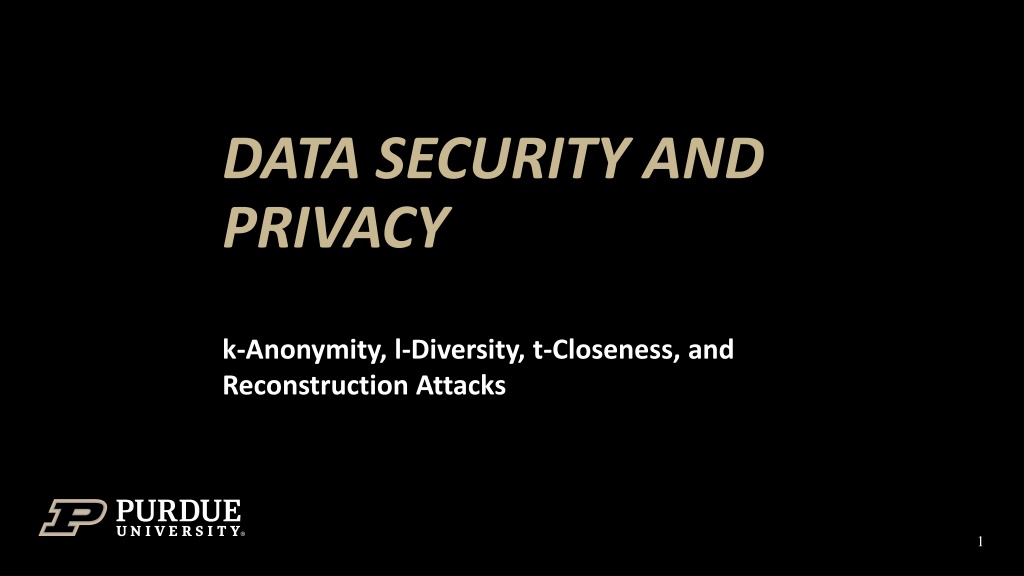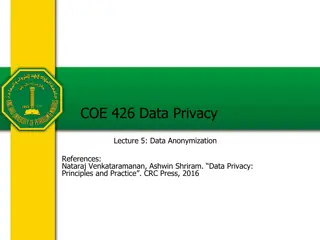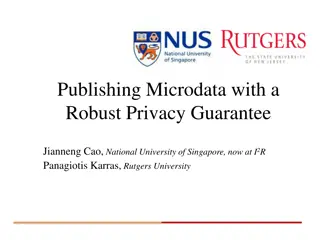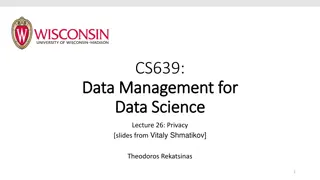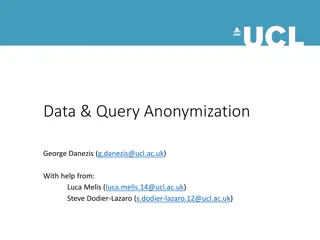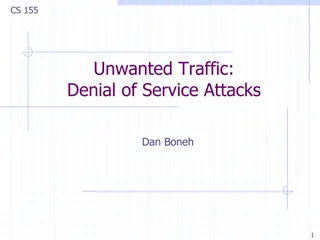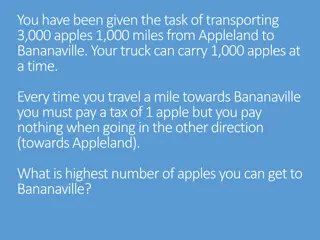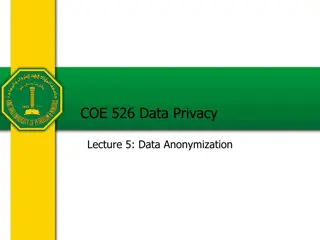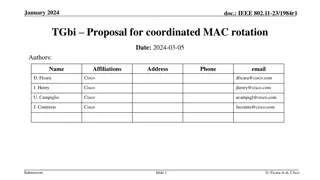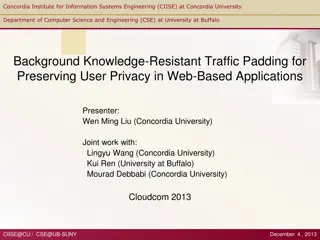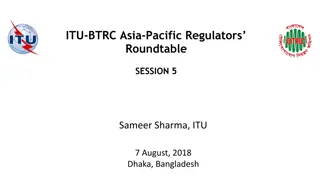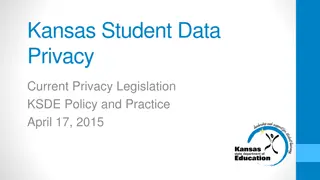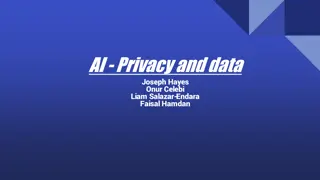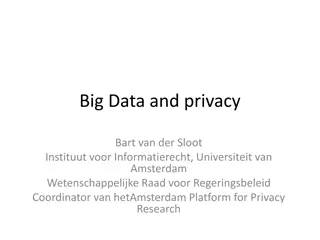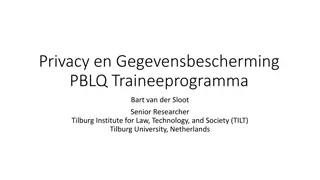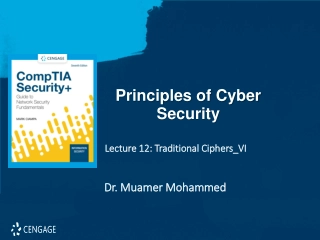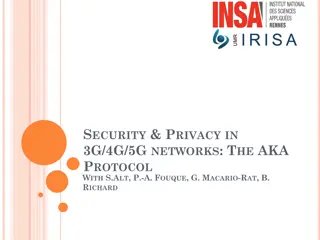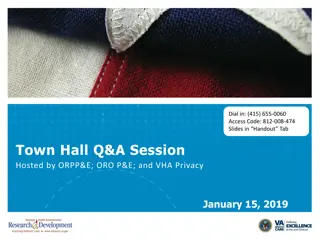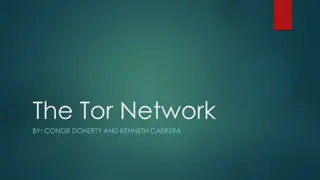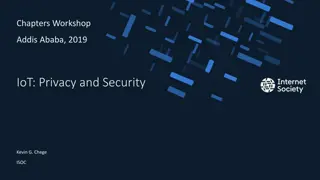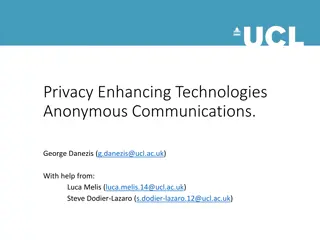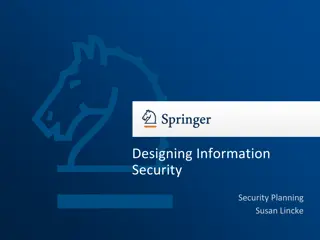Understanding Data Security and Privacy: An Overview of k-Anonymity, l-Diversity, t-Closeness, and Reconstruction Attacks
Delve into the realm of data security and privacy, exploring concepts such as k-Anonymity, l-Diversity, t-Closeness, and Reconstruction Attacks. Learn about the importance of privacy concerns, privacy-preserving data sharing, real threats of linking attacks, and specific instances like the GIC Incidence and AOL Data Release.
Uploaded on Sep 24, 2024 | 0 Views
Download Presentation

Please find below an Image/Link to download the presentation.
The content on the website is provided AS IS for your information and personal use only. It may not be sold, licensed, or shared on other websites without obtaining consent from the author. Download presentation by click this link. If you encounter any issues during the download, it is possible that the publisher has removed the file from their server.
E N D
Presentation Transcript
DATA SECURITY AND PRIVACY k-Anonymity, l-Diversity, t-Closeness, and Reconstruction Attacks 1
Readings for This Lecture t-Closeness: Privacy Beyond k- Anonymity and l-Diversity. Ninghui Li, Tiancheng Li, and Suresh Venkatasubramanian. In ICDE, April 2007.
Outline Privacy Incidences K Anonymity L Diversity T Closeness Reconstruction Attacks
All Kinds of Privacy Concerns Deciding what data to collect and why, how to use the data, and with whom to share data Communicate privacy policies to end users Ensure that data are used in ways consistent with privacy policies Protect collected data (security) Anonymity in communications Sharing data or using data for purposes in a way not allowed by privacy policies How?
Privacy Preserving Data Sharing It is often necessary to share data For research purposes E.g., social, medical, technological, etc. Mandated by laws and regulations E.g., census For security/business decision making E.g., network flow data for Internet-scale alert correlation For system testing before deployment However, publishing data may result in privacy violations
GIC Incidence [Sweeny 2002] Group Insurance Commissions (GIC, Massachusetts) Collected patient data for ~135,000 state employees. Gave to researchers and sold to industry. Medical record of the former state governor is identified. Patient 2 Patient 1 Patient n Name DoB Gender Zip code Disease Bob 1/3/45 M 47906 Cancer Carl 4/7/64 M 47907 Cancer GIC, MA Daisy 9/3/69 F 47902 Flu Emily 6/2/71 F 46204 Gastritis Flora 2/7/80 F 46208 Hepatitis DB Gabriel 5/5/68 F 46203 Bronchitis Re-identification occurs!
Real Threats of Linking Attacks Fact: 87% of the US citizens can be uniquely linked using only three attributes <Zipcode, DOB, Sex> Sweeney [Sweeney, 2002] managed to re-identify the medical record of the government of Massachusetts. Census data (income), medical data, transaction data, tax data, etc.
AOL Data Release [NYTimes 2006] In August 2006, AOL Released search keywords of 650,000 users over a 3-month period. User IDs are replaced by random numbers. 3 days later, pulled the data from public access. Thelman Arnold, a 62 year old widow who lives in Liburn GA, has three dogs, frequently searches her friends medical ailments. AOL searcher # 4417749 landscapers in Lilburn, GA queries on last name Arnold homes sold in shadow lake subdivision Gwinnett County, GA num fingers 60 single men dog that urinates on everything NYT Re-identification occurs!
Netflix Movie Rating Data [Narayanan and Shmatikov 2009] Netflix released anonymized movie rating data for its Netflix challenge With date and value of movie ratings Knowing 6-8 approximate movie ratings and dates is able to uniquely identify a record with over 90% probability Correlating with a set of 50 users from imdb.com yields two records Netflix cancels second phase of the challenge
Genome-Wide Association Study (GWAS) [Homer et al. 2008] A typical study examines thousands of singe-nucleotide polymorphism locations (SNPs) in a given population of patients for statistical links to a disease. From aggregated statistics, one individual s genome, and knowledge of SNP frequency in background population, one can infer participation in the study. The frequency of every SNP gives a very noisy signal of participation; combining thousands of such signals give high-confidence prediction
GWAS Privacy Issue Published Data Adv. Info & Inference Disease Group Avg Control Group Avg Population Avg Target individual Info yes Target in Disease Group SNP1=A 43% 42% + SNP2=A 11% 10% no - SNP3=A 58% 59% no + SNP4=A 23% 24% yes - Membership disclosure occurs!
Main Challenges How to define privacy for sharing data? How to publish/anonymize data to satisfy privacy while providing utility?
Attempts at Defining Privacy Preventing the following disclosures Identification disclosure Attribute disclosure Membership disclosure Simulating an ideal world
k-Anonymity [Sweeney, Samarati ] The Microdata A 3-Anonymous Table QID SA QID SA Zipcode Age Gen Disease Zipcode Age Gen Disease 47677 29 F Ovarian Cancer 476** 476** 476** 2* 2* 2* * * * Ovarian Cancer Ovarian Cancer Prostate Cancer 47602 22 F Ovarian Cancer 47678 27 M Prostate Cancer 47905 43 M Flu 4790* 4790* 4790* [43,52] [43,52] [43,52] * * * Flu Heart Disease Heart Disease 47909 52 F Heart Disease 47906 47 M Heart Disease k-Anonymity Attributes are separated into Quasi-identifiers (QIDs) and Sensitive Attributes (SAs) Each record is indistinguishable from k-1 other records when only quasi-identifiers are considered These k records form an equivalence class
k-Anonymity & Generalization k-Anonymity Each record is indistinguishable from at least k-1 other records These k records form an equivalent class k-Anonymity ensures that linking cannot be performed with confidence > 1/k. Generalization Replace with less-specific but semantically-consistent values 476** 2* * Female Male 47677 29 47602 47678 22 27 Zipcode Age Sex
Data Publishing Methods Generalization Make data less precise Suppression Remove certain data Segmentation Divide data up before publishing Perturbation Add noise/errors Data synthesis Synthesize similar data ???
Attacks on k-Anonymity k-anonymity does not prevent attribute disclosure if: Sensitive values lack diversity The attacker has background knowledge A 3-anonymous patient table Homogeneity Attack Zipcode Age Disease Bob 476** 476** 476** 2* 2* 2* Heart Disease Heart Disease Heart Disease Zipcode Age 47678 27 4790* 4790* 4790* 40 40 40 Flu Background Knowledge Attack Heart Disease Cancer Carl does not have heart disease 476** 476** 476** 3* 3* 3* Heart Disease Cancer Cancer Carl Zipcode Age 47673 36
l-Diversity [Machanavajjhala et al. 2006] The l -diversity principle Each equivalent class contains at least l well-represented sensitive values Instantiation Distinct l-diversity Each equi-class contains l distinct sensitive values Entropy l-diversity entropy(equi-class) log2(l)
Limitations of l-Diversity l-diversity may be difficult and unnecessary to achieve. Consider a single sensitive attribute Two values: HIV positive (1%) and HIV negative (99%) Very different degrees of sensitivity One would not mind being known to be tested negative but one would not want to be known/considered to be tested positive. l-diversity is unnecessary to achieve 2-diversity is unnecessary for an equi-class that contains only negative records. l-diversity is difficult to achieve Suppose there are 10000 records in total. To have distinct 2-diversity, there can be at most 10000*1%=100 equi-classes.
The Skewness Attack: An Example Two values for the sensitive attribute HIV positive (1%) and HIV negative (99%) Highest diversity still has serious privacy risk Consider an equi-class that contains an equal number of positive records and negative records. Using diversity and entropy does not differentiate: Equi-class 1: 49 positive + 1 negative Equi-class 2: 1 positive + 49 negative The overall distribution of sensitive values matters.
The Similarity Attack: An Example A 3-diverse patient table Zipcode Age Salary Disease Bob 476** 476** 476** 2* 2* 2* 20K 30K 40K Gastric Ulcer Gastritis Stomach Cancer Zip 47678 Age 27 4790* 4790* 4790* 40 40 40 50K 100K 70K Gastritis Flu Bronchitis Conclusion 1. Bob s salary is in [20k,40k], which is relative low. 2. Bob has some stomach- related disease. 476** 476** 476** 3* 3* 3* 60K 80K 90K Bronchitis Pneumonia Stomach Cancer The semantic meanings of attribute values matters.
How to Prevent These Attacks? Goal is to quantify/limit amount of information leakage through data publication. Looking only at the final output is inherently problematic because it cannot measure information gain.
Our Main Insight Revealing the overall distribution of the sensitive attribute in the whole dataset should be considered to have no privacy leakage (is an ideal world for privacy) In other words, we assume that removing all quasi-identifier attributes preserves privacy Seems unavoidable unless willing to destroy utility Also seems desirable from utility perspective Goal is to simulate this ideal world.
t-Closeness [Li et al. 2007] Rationale Belief Knowledge B0 External Knowledge
t-Closeness [Li et al. 2007] Rationale A completely generalized table Age Zipcode Gender Disease 2* 479** Male Flu Belief Knowledge 2* 479** Male Heart Disease B0 External Knowledge 2* 479** Male Cancer . . . . . . . . . . . . 50 4766* * Gastritis
t-Closeness [Li et al. 2007] Rationale Belief Knowledge B0 B1 External Knowledge Overall distribution Q of sensitive values
t-Closeness [Li et al. 2007] Rationale A released table Age Zipcode Gender Disease * * * Flu * * * Heart Disease Belief Knowledge * * * Cancer B0 B1 External Knowledge . . . . . . . . . . . . Overall distribution Q of sensitive values * * * Gastritis
t-Closeness [Li et al. 2007] Rationale Belief Knowledge B0 B1 External Knowledge Overall distribution Q of sensitive values B2 Distribution Pi of sensitive values in each equi-class
t-Closeness [Li et al. 2007] Rationale Q should be public information The distribution Q is always available to the attacker as long as one wants to release the data at all. We separate knowledge gain into two parts: Belief Knowledge About the whole population (from B0 to B1) B0 B1 External Knowledge Overall distribution Q of sensitive values About specific individuals (from B1 to B2) We bound knowledge gain between B1 and B2 instead B2 Distribution Pi of sensitive values in each equi-class Principle The distance between Q and Pi should be bounded by a threshold t.
t-Closeness Principle: Distribution of sensitive attribute value in each equi-class should be close to that of the overall dataset (distance t) How to measure distance between two distributions so that semantic relationship among sensitive attribute values is captured. Assume distribution of income is (10K, 20K, 30K, , 90K); intuitively (20K,50K,80K) is closer to it than (10K,20K,30K).
The Earth Mover Distance We use Earth Mover Distance. Distance between (10K, 20K, 30K, , 90K) and (20K,50K,80K) is 0.1 1 9 6 = Distance between (10K, 20K, 30K, , 90K) and (10K,20K,30K) is 1 9 (0.3 + 0.4 + 0.4 + 0.5 + 0.5 + 0.6) = 0.3 2 30 0.0067
Limitations of t-Closeness Utility may suffer too much, since interesting and significant deviation from global distribution cannot be learned. (n,t)-closeness: Distribution of sensitive attribute value in each equi-class should be close to that of some natural super-group consisting at least n tuples Okay to learn information about a large group.
(n,t)-Closeness One may argue that requiring t-closeness may destroy data utility The notion of (n,t)-closeness requires distribution close to a large-enough natural group of size at least n Intuition: It is okay to learn information about the a big group It is not okay to learn information about one individual
Other Limitations Requires the distinction between Quasi-identifiers and sensitive attributes The t-closeness notion is a property of input dataset and output dataset, not that of the algorithm; thus additional information leakage is possible when the algorithm is known
Limitation of These Privacy Notions Limitation of previous privacy notions: Requires identifying which attributes are quasi-identifier or sensitive, not always possible Difficult to pin down adversary s background knowledge There are many adversaries when publishing data Syntactic in nature (property of anonymized dataset)
Privacy Notions: Syntactic versus Algorithmic Syntactic: Privacy is a property of only the final output Algorithmic: Privacy is a property of the algorithm Syntactic notions are typically justified by considering a particular inferencing strategy; however, adversaries may consider other sources of information E.g., Minimality Attack
Illustrating the Syntactic Nature of k-Anonymity Method 1 for achieving k anonymity: Duplicating each record k times Method 2: clusters records into groups of at least k, use one record from each group to replace all other records in the group Privacy of some individuals are violated Method 3: cluster records into groups, then use generalized values to replace the specific values (e.g., consider a 2-D space) Record with extraordinary values are revealed/re-identified
Reconstruction Attacks Readings Garfinkel, Abowd, Martindale, Understanding Database Reconstruction Attacks on Public Data, ACM Queue 2018. Section 8.1 of Dwork and Roth: The Algorithmic Foundations of Differential Privacy. Optional: Dinur and Nissim, Revealing Information while Preserving Privacy, Proceedings of ACM Symposium on Principles Of Database Systems 2003. Cohen and Nissim, Linear Program Reconstruction in Practice, Journal of Privacy and Confidentiality, 2020. 38
Fictional Statistical Queries with Answers for illustrating reconstruction attacks. When count<3, results are suppressed. What can be inferred? 39
Data Reconstruction Attacks using SAT Solver Seven records, assign variables to possible values The statistics provides constraints Manual inference is possible For automated attack, can be reconstructed using SAT solvers 40
The Dinur Nissim Paper Study the privacy impact of answering statistical queries. Setting: Each record has some attributes so that they can be selected in queries. For simplicity, assume that each record has a unique name/id. Each record has one sensitive bit. A query asks for the sum of sensitive bit in some subset. 42
Definition 8.1. A mechanism is blatantly non-private if an adversary can construct a candidate database c that agrees with the real database d in all but o(n) entries, i.e., ||c d||0 o(n). 43
Theorem 8.1. [Inefficient Reconstruction Attacks]: Let M be a mechanism with distortion of magnitude bounded by E. Then there exists an adversary that can reconstruct the database to within 4E positions. Query every subset, output a dataset that is consistent with all queries. Efficient Linear Reconstruction Attacks. Issue random subset queries, then use linear programs to find a solution. 44
